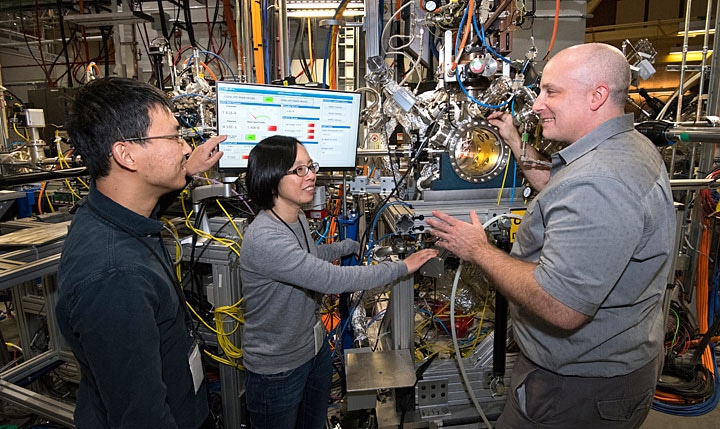Dec 27 2018
Although hydrogen fuel cells have been shown to be a potential technology for generating clean, renewable energy, the activity and cost of their cathode materials pose a considerable problem for commercialization.
 Brookhaven Lab scientists Mingyuan Ge, Iradwikanari Waluyo, and Adrian Hunt are pictured left to right at the IOS beamline, where they studied the growth pathway of an efficient catalyst for hydrogen fuel cells. (Image credit: Brookhaven National Laboratory)
Brookhaven Lab scientists Mingyuan Ge, Iradwikanari Waluyo, and Adrian Hunt are pictured left to right at the IOS beamline, where they studied the growth pathway of an efficient catalyst for hydrogen fuel cells. (Image credit: Brookhaven National Laboratory)
Costly platinum-based catalysts, which are substances triggering and expediting chemical reactions, are required for a majority of fuel cells. These catalysts help in changing renewable fuels into electrical energy. Therefore, in order to make hydrogen fuel cells commercially feasible, researchers are looking for more inexpensive catalysts that can offer the same level of efficiency as that of pure platinum.
“Like a battery, hydrogen fuel cells convert stored chemical energy into electricity. The difference is that you’re using a replenishable fuel so, in principle, that ‘battery’ would last forever,” stated Adrian Hunt, a scientist at the National Synchrotron Light Source II (NSLS-II), a U.S. Department of Energy (DOE) Office of Science User Facility at DOE’s Brookhaven National Laboratory. “Finding a cheap and effective catalyst for hydrogen fuel cells is basically the holy grail for making this technology more feasible.”
Participating in this global search for fuel cell cathode materials, scientists at the University of Akron devised a novel approach for producing catalysts from a mixture of metals such as nickel and platinum that form eight-sided or octahedral-shaped nanoparticles. Although this catalyst has been identified as one among the most efficient substitutes for pure platinum, researchers have not completely figured out why it grows in an octahedral shape. Hence, to gain a better insight into the growth process, the investigators at the University of Akron teamed up with numerous institutions, which also included Brookhaven and its NSLS-II.
Understanding how the faceted catalyst is formed plays a key role in establishing its structure-property correlation and designing a better catalyst. The growth process case for the platinum-nickel system is quite sophisticated, so we collaborated with several experienced groups to address the challenges. The cutting-edge techniques at Brookhaven National Lab were of great help to study this research topic.
Zhenmeng Peng, Principal Investigator, Catalysis Lab, University of Akron.
The researchers used the ultra-bright X-rays at NSLS-II as well as the sophisticated capabilities of NSLS-II’s In situ and Operando Soft X-ray Spectroscopy (IOS) beamline and successfully exposed the chemical characterization of the growth pathway of the catalyst in real time. The study results have been reported in Nature Communications.
“We used a research technique called ambient-pressure x-ray photoelectron spectroscopy (AP-XPS) to study the surface composition and chemical state of the metals in the nanoparticles during the growth reaction,” stated Iradwikanari Waluyo, a co-corresponding author of the research paper and lead scientist at IOS. “In this technique, we direct x-rays at a sample, which causes electrons to be released. By analyzing the energy of these electrons, we are able to distinguish the chemical elements in the sample, as well as their chemical and oxidation states.”
Hunt, who is also the paper’s author, added that “It is similar to the way sunlight interacts with our clothing. Sunlight is roughly yellow, but once it hits a person’s shirt, you can tell whether the shirt is blue, red, or green.”
Instead of colors, the researchers were discovering chemical information on the catalyst’s surface and comparing it to its interior. They found that at the time of the growth reaction, it is the metallic platinum that forms first and turns out to be the center of the nanoparticles, and later when the reaction achieves a somewhat higher temperature, platinum helps in forming metallic nickel, which subsequently separates to the nanoparticle’s surface. During the last stages of growth, the surface becomes an almost equivalent mixture of the two metals, that is, nickel and platinum. This fascinating synergistic effect between nickel and platinum has a key role to play in the development of the octahedral shape of the nanoparticle and also its reactivity.
“The nice thing about these findings is that nickel is a cheap material, whereas platinum is expensive,” stated Hunt. “So, if the nickel on the surface of the nanoparticle is catalyzing the reaction, and these nanoparticles are still more active than platinum by itself, then hopefully, with more research, we can figure out the minimum amount of platinum to add and still get the high activity, creating a more cost-effective catalyst.”
The study findings relied on the sophisticated capabilities of IOS, where the scientists were able to perform the experiments at gas pressures higher than what is typically feasible in traditional XPS experiments.
“At IOS, we were able to follow changes in the composition and chemical state of the nanoparticles in real time during the real growth conditions,” stated Waluyo.
The work at NSLS-II was complemented by additional X-ray and electron imaging studies, which were performed at the Advanced Photon Source (APS) at DOE’s Argonne National Laboratory—another DOE Office of Science User Facility—and University of California-Irvine, respectively.
“This fundamental work highlights the significant role of segregated nickel in forming the octahedral-shaped catalyst. We have achieved more insight into shape control of catalyst nanoparticles,” stated Peng. “Our next step is to study catalytic properties of the faceted nanoparticles to understand the structure-property correlation.”
The National Science Foundation and Brookhaven’s Laboratory Directed Research and Development program supported the study. Operations at APS and NSLS-II are supported by DOE’s Office of Science.